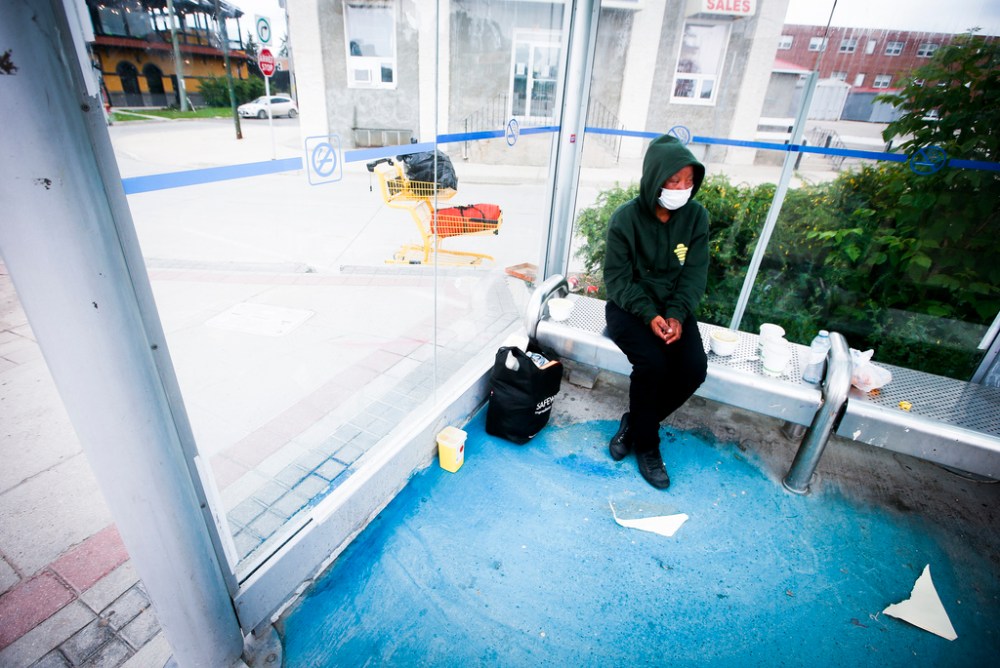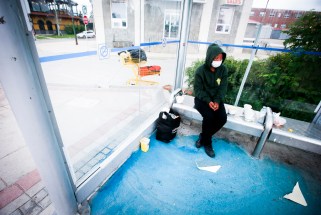A roof but hardly a home Proposal to dismantle transit shelters hotly debated, but rarely heard is a voice from within
Read this article for free:
or
Already have an account? Log in here »
To continue reading, please subscribe:
Monthly Digital Subscription
$0 for the first 4 weeks*
- Enjoy unlimited reading on winnipegfreepress.com
- Read the E-Edition, our digital replica newspaper
- Access News Break, our award-winning app
- Play interactive puzzles
*No charge for 4 weeks then price increases to the regular rate of $19.00 plus GST every four weeks. Offer available to new and qualified returning subscribers only. Cancel any time.
Monthly Digital Subscription
$4.75/week*
- Enjoy unlimited reading on winnipegfreepress.com
- Read the E-Edition, our digital replica newspaper
- Access News Break, our award-winning app
- Play interactive puzzles
*Billed as $19 plus GST every four weeks. Cancel any time.
To continue reading, please subscribe:
Add Free Press access to your Brandon Sun subscription for only an additional
$1 for the first 4 weeks*
*Your next subscription payment will increase by $1.00 and you will be charged $16.99 plus GST for four weeks. After four weeks, your payment will increase to $23.99 plus GST every four weeks.
Read unlimited articles for free today:
or
Already have an account? Log in here »
Hey there, time traveller!
This article was published 23/06/2022 (1264 days ago), so information in it may no longer be current.
On a sticky-hot evening, the bus shacks of Winnipeg sit mostly empty, void both of people waiting for the bus and of people who find under their roofs a sheltered, if not entirely comfortable, place to stay. For all the words about the latter groups that have spackled the news as of late, there are few out tonight. Not on Regent, or Pembina, or Osborne, or North Main.
There is one person. In a shelter at the awkward intersection where Marion Street and St. Mary’s Road meet, Samantha Thomas sits on the bench, arranging containers of soup. Soon, she’ll pack her cart with all her things — a tent, some blankets, a thrift store Bible — and head south to find a quieter shack to bunk in for the night.
“I do this every day, back and forth,” she says. “When nighttime comes, I’ll go sleep in St. Vital. It’s actually scary over there, because I’m all alone in the bus shelter and everybody’s gone. I can’t believe I stay out there by myself, but when you’re tired, you’re tired.”

This bus shelter is already in bad condition. Two of the wall panels have been smashed out; Thomas, 27, was sleeping when it happened. She didn’t even know that it had been busted until the cops came, and she woke up to find the shack inundated by rain.
“I was like, ‘how did the cops know it was smashed and I didn’t?’” she says, and laughs.
Thomas has been sleeping out here for a few years, she thinks. In summer and winter. The winter isn’t so bad, she says, and in fact she sort of prefers it; it all depends if you have the right things, she says. You need the right things to make it through certain days, and over time, she’s learned what those things are and where to find them.
“I do this every day, so I got used to it,” she says.
So she has learned to live in the shelters, but the city has still not learned how best to live with people like her.
Just days before, after some debate, the city’s executive policy committee voted 6-1 against a motion put forth by Transcona councillor Shawn Nason to remove the walls, doors and seats from two bus shelters in front of Kildonan Place mall. It would leave only a roof denuded of real shelter; the motion had been green-lit by the public works committee a week earlier.
Nason stepped back from that motion himself this week, but not before it had sparked a passionate public discussion. At the EPC meeting, advocates for vulnerable Winnipeggers staged a stiff resistance to the motion; over a dozen delegates spoke against it.
Their message was simple: dismantling shelters doesn’t address any of the reasons that people stay in them. And while transit riders need the shelters to be safe and available, removing their functionality only strips it from everyone, particularly seniors and people with disabilities.
“No one is arguing that living in a tent or a bus shack is a right,” End Homelessness Winnipeg communications manager Kris Clemens told EPC. “It is a physical manifestation of the violation of one’s human right to adequate housing.”
Those people, the ones who lack adequate housing, are stakeholders in this debate, too. But what opinions they might have on what dismantling the shelters would do, or what would help them find more stable and healthier situations, city council didn’t hear directly; the most vulnerable are rarely given space to speak for themselves, in these situations.

In the bus shack at the intersection of Marion and St. Mary’s, Thomas hasn’t heard about the city council debate. She hasn’t heard some wanted to take down the walls of two shelters on Regent. But she does know what it is like to live in them, and how to make the best of a difficult situation, and her observations line up with what advocates at the EPC meeting were saying.
At EPC, West Central Women’s Resource Centre director Lorie English urged the city to invest in safe consumption sites for people who use drugs, so they aren’t pushed into public spaces; just days before, one of Thomas’s friends overdosed in a bus shelter nearby. That was the first time Thomas had seen a dead body, she said, and the experience left her shaken.
Sometimes, she says, she’s doesn’t remember everything that’s happened in her life, or understand its events clearly. Last week, advocates for unhoused people told city council that many unhoused people have suffered traumatic brain injuries; now, in this bus shelter, Thomas is explaining that people “bother her a lot” when she’s sleeping.
“When you hit somebody on the head too much, it does affect your brain,” she says.
And she talks about the limited options she has to live a dignified life on the street. She’s been chased out of places, and had her survival kit removed from the shacks by city staff. Unhoused people are not welcome in most private spaces, so they can only cling to what public spaces they find. She points at the nearby strip mall, dotted with fast-food restaurants.
“They kicked us out of all these places, all these stores,” she says. “We can’t even go in there, we can’t even use the bathroom. I have to find a bucket to pee in. Then Winnipeg Transit comes along, and they take all our stuff, and we have to go walking around and look for blankets and do it all over again.
“They’re taking those donation bins away too, and then we won’t have nothing like that. Then where are we supposed to go? We have to follow their system? No, we don’t want to sit there and be used, and be bullied. Nobody wants to live by their rules. I don’t want to do it. I already know who they are.”
It is not entirely clear who “they” are, in this thought, and Thomas doesn’t elaborate further. What she does say is that she doesn’t like staying in shelters: it’s the people, she says. Living on the street gives her some measure of autonomy over who she spends time around, and if she isn’t comfortable with a situation, she can always move on somewhere else.
Still, it’s hard. The worst part, she says, is being alone when something bad happens: “you can’t defend yourself.” Or when she’s starving, or when she’s hurt. She thinks she could maybe find housing, she says, but she doesn’t seem all too sure. It’s “really hard right now,” she says, and she has a lot of concerns about who she would end up having to stay with.
“You have nothing,” she says. “I’ve been here so long, I’ve been hurt so much. You don’t see security coming to help us.”

What does help, she says, are the vans that drive around from groups such as Main Street Project and Street Connections. Those are the most helpful resources she knows. Her friends help too, even though they are equally limited in means. Still, the people who live without houses take care of each other. Because they understand each other. Because they must.
“My friends, they’ll come along, they’ll help me the best they can,” she says. “But they can’t do much.”
Maybe, someday, the city will have more safe places where she and her friends are welcome. This week might have brought us a little closer to it.
On Wednesday, Nason announced he would not support his own motion to dismantle the shelters, which faced a full council vote on Thursday; instead, he’d get behind a proposal by Coun. Sherri Rollins, calling on the city’s public works department to develop options for low-barrier housing and safe consumption sites.
It’s hopeful, in a way. The machinations of city council will not right away trickle down to the lives of people on the street; but in this case, at least, council heard the truth of what’s needed, versus what will only drive vulnerable people deeper into harm’s way.
melissa.martin@freepress.mb.ca
Our newsroom depends on a growing audience of readers to power our journalism. If you are not a paid reader, please consider becoming a subscriber.
Our newsroom depends on its audience of readers to power our journalism. Thank you for your support.



.jpg?h=215)



.jpg?h=215)
